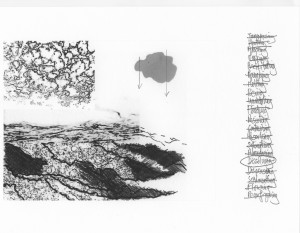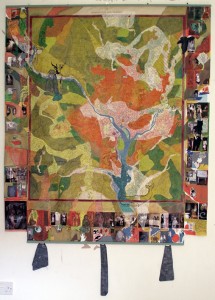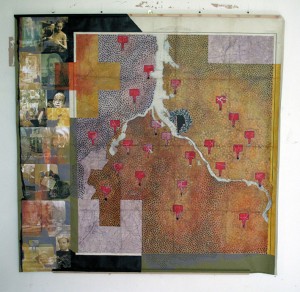
We moved into our new home just a week ago and, after what seems rather longer grappling with a sea of brown cardboard boxes, problems with drains, and all the other dubious joys of domesticity associated with moving house, I returned briefly to another of my lives today.
I have been in Exeter giving a joint presentation at the Royal Geographical Society annual conference with Antony Lyons as part of the session Geo-aesthetics in an Anthropogenic World. The convenors, Deborah Dixon (Glasgow) and Dominic Walker (Exeter), had kindly given us a double ‘slot’, which allowed us to show Antony’s most recent edit of Transgression (Rising Waters) immediately followed by a textual ‘duet’ in which we each read in turn a short response to fifteen of the words listed on the digital drawings I made for that project. (See one example above). Given that we had not had any time to rehearse this it went surprisingly well, largely because Antony had carefully structured the presentation so that the drawings gave us a clear ‘time slot’.
Our abstract – which does more or less reflect what we delivered (!) reads as follows:
We take as our starting point the definition of ‘Transgression’, as a geological term describing an advance of the sea over land-areas: ‘a relative rise in sea level resulting in deposition of marine strata over terrestrial strata. The sequence of sedimentary strata formed by transgressions and regressions provides information about the changes in sea level during a particular geologic time’’
This moving-image work is based on a combination of fieldwork, archival research, creative conversations and inter-media collage. Drawing on our shared interest in place, environmental change, and water landscapes, we explore questions rooted in physical, social and cultural relationships between land and sea. In an era that many now term the ‘Anthropocene’, it can be argued that we face the prospect of human-influenced marine transgressions. Using strategies of poetic juxtaposition and conjecture, we focus special attention on coastal change/resilience/adaptation along the Severn Estuary coast, as well as wider afield. Our hybrid composition incorporates photographic and other visual content, accompanied by voice, song and soundscape. It weaves together original and archival material to create an imaginative bridging and transgressing of both disciplinary thinking and the culture of possessive individualism that underpins it. The method is influenced by Lyons’ work as a geoscientist and landscape-based artist; and by Biggs’ academic and artistic work embracing ‘deep-mapping’ as a creative paradigm. Our many antecedents include films such as Chris Marker’s Sans Soleil and the socio-ecological thinking of Deleuze and Guattari, coupled with Pearson and Shanks’ re-visioning of ‘deep mapping’ as a regionalist performative creative strategy. Transgression (Rising Waters) is closely linked to a Lyons’ longer-term Arts Council funded project ‘Inundation – Drowned Lands’ and to his artist residency project on the Severn Estuary, called ‘Sabrina Dreaming’.
Of particular interest to me about the session as a whole was that the collaborative presentation – by Rebecca Ellis (a social anthropologist with interests in science, technology and cultural geography) and the artist Sarah Casey – that preceded ours. Titled Porous topologies of (Im)perceptibility’s as creative process, the abstract for this reads as follows:
Two reflections from theoretical cosmology provide the inspiration for this paper. The first is an acknowledgement that light is but a one-dimensional signal of (non)human knowability of the properties of the universe. The second is the claim that properties as-of-yet unknowable are mathematically thinkable, albeit in the absence of observational verification. Current cosmological debates concerning the (non)existence of manifold topologies of the multiverse (e.g. Smolin 2015) provide a rich context in which to both stay with and trouble claims for (un)knowability as a resource for tentatively grasping the radically insensible (Yusoff 2013). Indeed the deep recesses of the (non)existent multiverse promise to usefully probe further the very meanings of (non)human perceptibility. This paper will practice a recent interdisciplinary experiment between an artist, anthropologist and cosmologist as they exchange theoretical and material resources with which they individually and collectively trouble the limits of (im)perceptibility posed by the example given. Theoretical reflection on the status of mathematics as (non)human signal, will tentatively steer between accounts of mathematical ontology (Badiou, Meillassoux) and feminist materialist consideration of mathematics as human-nonhuman semiotic exchange (e.g. Kirby). We reflect upon the problem of seeking ‘illumination’ of dark objects through the example of Art practice, where ‘knowing’ is deliberately postponed and a state of being ‘in the dark’ is essential to enriched understanding (Jones 2013).The paper will be framed by a wider-arching question concerning the possibilities of the utter (ir)relevance of such radically ‘dark spaces’ for anthropocenic thinking.
There was something in all this that reminded me of the Hebrew mystical concept of Ein Sof, which in the study of the Kabbalah is understood as God prior to his self-manifestation in the production of any spiritual realm. In this line of thought, it is only by withdrawing into absence that the Divine can allow anything (else) to come into being. There was a sense of a queer interdependence/distance, of an ‘oscillation’, hinted at in the paper that was fascinating. Anyway, and probably rather to everyone’s surprise, there turned out to be a number of tantalising overlaps between this presentation and our own. These appeared in various ways, not least in Rebecca Ellis’ question to me about my use of the term ‘polyverse’ (against the more usual ‘multiverse’). Strangely, it seems Antony and I have been edging towards a possible convergence with thinking in mathematical speculation about multiverses, along with the debates for and against Object Oriented Ontology. Two particularly interesting lines of enquiry (for me) came out of this heady stuff. Firstly, a recommendation that I read Mary Jane Rubenstein’s The Many Worlds of the Multiverse. But secondly (for me) the positive provocation of Sarah Casey’s resonant and technically deeply thoughtful approach to her drawings.
So much food for thought before my re-imersion in the sea of brown cardboard boxes!


